24 june 2018
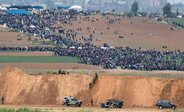
The Palestinian Ministry of Health (MOH) in Gaza has issued an updated count of Palestinian casualties since the “Great March of Return” began on March 30th, in the besieged Gaza Strip.
The Ministry announced, late Sunday, that the total number of Palestinians killed by Israeli forces is 131, including 15 children and a woman, since the weeks-long massive demonstrations began.
The total number of injuries and gas inhalation was 14,811, of which 6,836 were treated in the field at medical points and 7,775 were treated in hospitals. Among the injured were 2,525 children and 1,158 women, according to the statement.
Of the total injuries, 3,947 are related to live ammunition, 427 with rubber bullets, 1466 are of tear-gas suffocation; 366 of the injuries are critical, 3,746 were declared moderate and 10,699 light.
Fifty-four amputations were carried out; seven of them in the upper extremities, 47 in the lower extremities, Al Ray reports.
The ministry said that two paramedic, including a female paramedic were killed, and 229 medics were injured with live ammunition and tear-gas suffocation, while 39 ambulances were partly damaged.
Meanwhile, the Forum of Palestinian Journalists in the Gaza Strip said that two journalists, Yasser Murtaja and Ahmad Abu Hussein, were killed during the protests.
The forum added that 175 journalists were injured since the beginning of the marches.
The Ministry announced, late Sunday, that the total number of Palestinians killed by Israeli forces is 131, including 15 children and a woman, since the weeks-long massive demonstrations began.
The total number of injuries and gas inhalation was 14,811, of which 6,836 were treated in the field at medical points and 7,775 were treated in hospitals. Among the injured were 2,525 children and 1,158 women, according to the statement.
Of the total injuries, 3,947 are related to live ammunition, 427 with rubber bullets, 1466 are of tear-gas suffocation; 366 of the injuries are critical, 3,746 were declared moderate and 10,699 light.
Fifty-four amputations were carried out; seven of them in the upper extremities, 47 in the lower extremities, Al Ray reports.
The ministry said that two paramedic, including a female paramedic were killed, and 229 medics were injured with live ammunition and tear-gas suffocation, while 39 ambulances were partly damaged.
Meanwhile, the Forum of Palestinian Journalists in the Gaza Strip said that two journalists, Yasser Murtaja and Ahmad Abu Hussein, were killed during the protests.
The forum added that 175 journalists were injured since the beginning of the marches.
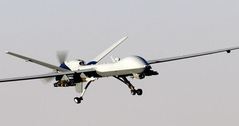
Three Palestinians were left injured on Sunday evening in an Israeli airstrike on the blockaded Gaza Strip.
Israeli drones dropped two missiles on a group of Palestinian youths gathering east of the Awda refugee camp, in central Gaza Strip.
Sometime earlier, an Israeli offensive targeted a motorcycle in Gaza.
The Israeli military spokesman claimed the army targeted a vehicle used in flowing kites and incendiary balloons from southern Gaza toward Israeli settlements adjacent to the border area.
Over the past few days, a series of fires broke out in Israeli settlements on the Gaza border after Palestinian anti-occupation protesters unleashed helium-filled balloons in response to Israeli aggressions the Great March of Return protests, which have been ongoing since March 30.
Israeli drones dropped two missiles on a group of Palestinian youths gathering east of the Awda refugee camp, in central Gaza Strip.
Sometime earlier, an Israeli offensive targeted a motorcycle in Gaza.
The Israeli military spokesman claimed the army targeted a vehicle used in flowing kites and incendiary balloons from southern Gaza toward Israeli settlements adjacent to the border area.
Over the past few days, a series of fires broke out in Israeli settlements on the Gaza border after Palestinian anti-occupation protesters unleashed helium-filled balloons in response to Israeli aggressions the Great March of Return protests, which have been ongoing since March 30.
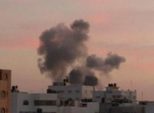
Palestinian medical sources have confirmed, on Sunday evening, that three residents were injured after an Israeli drone fired a missile at them while riding a motorcycle east of the Zeitoun neighborhood, east of Gaza city.
The sources said the three Palestinians were rushed to the Shifa Medical Center in Gaza city, suffering moderate-to-severe wounds.
The Palestinians were targeted by the drone in Malka Junction area, in the Zeitoun neighborhood, in Gaza city.
Furthermore, the army fired a tank shell at a site, east of the al-Boreij refugee camp in central Gaza, causing damage.
On its part, the Israeli army claimed it fired a missile at what was described as a “wagon transporting incendiary balloons,” wounding three Palestinians.
The sources said the three Palestinians were rushed to the Shifa Medical Center in Gaza city, suffering moderate-to-severe wounds.
The Palestinians were targeted by the drone in Malka Junction area, in the Zeitoun neighborhood, in Gaza city.
Furthermore, the army fired a tank shell at a site, east of the al-Boreij refugee camp in central Gaza, causing damage.
On its part, the Israeli army claimed it fired a missile at what was described as a “wagon transporting incendiary balloons,” wounding three Palestinians.
“And the Middle East is aflame again. I mean there’s lots of a Palestinian kids being killed further south as well by the Israeli forces,” Marr interjected during the conversation in reference to the violent Gaza border riots.
The Mail Online said that the BBC’s “extraordinary ruling against one of its most senior personalities is almost unprecedented.”
Complaining against Marr’s comment, anti-semitism campaigner Jonathan Sacerdoti emphasized that the TV made the comments even though they were entirely unrelated to the matter being discussed at the time.
‘When talking about a story on the use of chemical weapons in Syria, Andrew Marr for some reason decided to talk about Israel (which was unrelated anyway). He stated there’s a lot of Palestinian kids being killed further south by Israeli forces,” he is quoted as saying in the Mail Online.
‘This is completely incorrect and is made up. This was irrelevant to the conversation on Syria … and also actually completely false,’ Sacerdoti said about the program that was broadcast on April 8.
The BBC’s latest conclusions constitute a mea culpa after the station initially attempted to defend Marr’s words, noting that five ‘younger people’ had been killed between the beginning of the year and the date the program was aired.
The BBC also attempted to back Marr by saying that several Palestinian children and younger people had been killed in the week following the broadcast.
However, Sacerdoti argued that later events could not be used to justify Mr Marr’s comments which were made prior to the cited deaths.
Eventually, head of executive complaints at the BBC, Fraser Steel, responded to Sacerdoti, acknowledging that Marr’s accusations were not based on “sound evidence”, which he said the BBC’s guidelines required.
“In the absence of any evidence to support the reference to ‘lots’ of children being killed at the time of transmission, it seems to us to have risked misleading audiences on a material point. We therefore propose to uphold this part of your complaint,” the response read.
The Mail Online said that the BBC’s “extraordinary ruling against one of its most senior personalities is almost unprecedented.”
Complaining against Marr’s comment, anti-semitism campaigner Jonathan Sacerdoti emphasized that the TV made the comments even though they were entirely unrelated to the matter being discussed at the time.
‘When talking about a story on the use of chemical weapons in Syria, Andrew Marr for some reason decided to talk about Israel (which was unrelated anyway). He stated there’s a lot of Palestinian kids being killed further south by Israeli forces,” he is quoted as saying in the Mail Online.
‘This is completely incorrect and is made up. This was irrelevant to the conversation on Syria … and also actually completely false,’ Sacerdoti said about the program that was broadcast on April 8.
The BBC’s latest conclusions constitute a mea culpa after the station initially attempted to defend Marr’s words, noting that five ‘younger people’ had been killed between the beginning of the year and the date the program was aired.
The BBC also attempted to back Marr by saying that several Palestinian children and younger people had been killed in the week following the broadcast.
However, Sacerdoti argued that later events could not be used to justify Mr Marr’s comments which were made prior to the cited deaths.
Eventually, head of executive complaints at the BBC, Fraser Steel, responded to Sacerdoti, acknowledging that Marr’s accusations were not based on “sound evidence”, which he said the BBC’s guidelines required.
“In the absence of any evidence to support the reference to ‘lots’ of children being killed at the time of transmission, it seems to us to have risked misleading audiences on a material point. We therefore propose to uphold this part of your complaint,” the response read.
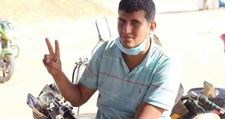
Osama Abu Khater 29
A Palestinian young man was proclaimed dead at dawn Sunday after he succumbed to a bullet injury he sustained last Friday during his participation in a March of Return protest staged on the Gaza border.
According to a spokesman for the health ministry, the young man is 29-year-old Osama Abu Khater. He died of a bullet injury in his abdomen during his presence in a border area east of Khan Younis.
After the death of Abu Khater, the number of March of Return martyrs have risen to 138 citizens, six of them still held by the Israeli occupation authority.
A Palestinian young man was proclaimed dead at dawn Sunday after he succumbed to a bullet injury he sustained last Friday during his participation in a March of Return protest staged on the Gaza border.
According to a spokesman for the health ministry, the young man is 29-year-old Osama Abu Khater. He died of a bullet injury in his abdomen during his presence in a border area east of Khan Younis.
After the death of Abu Khater, the number of March of Return martyrs have risen to 138 citizens, six of them still held by the Israeli occupation authority.
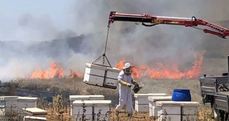
Incendiary kites and balloons launched from Gaza Strip sparked 26 fires on Saturday in Israeli settlements located in the vicinity of Gaza Strip including outposts of Kissufim, Givat Yehuda, Kibbutz Erez, Nahal Oz and Netiv Ha'asara, according to Yedioth Ahronoth Hebrew newspaper.
The Israeli newspaper said that Israeli extinguishing crews put out the fires and pointed out that large areas of lands were caught on fire due to weather conditions.
The Israeli newspaper said that Israeli extinguishing crews put out the fires and pointed out that large areas of lands were caught on fire due to weather conditions.
23 june 2018
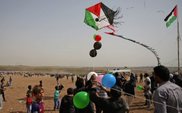
Israeli Justice Minister Ayelet Shaked has warned that her government may launch a new war on Gaza Strip because Palestinians continue to fly “incendiary kites” over Israeli farms.
Shaked said that Israel, which developed the iron dome anti-missile system, is able to develop a new system to take down the Palestinian kites. She claimed that the Palestinian children who fly kites are “terrorists” involved in “terrorism.”
The minister echoed similar remarks made by the Israel’s Public Security Minister, Gilad Erdan, who was reported by Haaretz, on Thursday, as saying that Israel might be “forced” to launch a “large-scale military operation” in the Gaza Strip.
“I do not want to launch an operation, but there is a good chance that we will have no other option but to go in so that we can create durable deterrence,” he told Israeli Army Radio.
Erdan added, according to Days of Palestine, that those who launch ‘burning kites’ from Gaza should be shot, regardless of their age. “Age does not matter,” he insisted. “They are terrorists and the danger they create must be prevented.”
The Palestinians in the Gaza Strip continue to point out that their protests are entirely legitimate under international law.
To call them terrorists, they insist, is not only inaccurate, but also an attempt by the Israelis and their supporters to deceive the world about the nature of the conflict in occupied Palestine.
It is worth mentioning that Israel has started to launch drone attacks against Palestinian children who fly kites along the eastern borders of the Gaza Strip.
06/23/18 Israel Turns Gaza into ‘Arms Race’ Laboratory, While Palestinians Fly Kites (pt 1/2)
Shaked said that Israel, which developed the iron dome anti-missile system, is able to develop a new system to take down the Palestinian kites. She claimed that the Palestinian children who fly kites are “terrorists” involved in “terrorism.”
The minister echoed similar remarks made by the Israel’s Public Security Minister, Gilad Erdan, who was reported by Haaretz, on Thursday, as saying that Israel might be “forced” to launch a “large-scale military operation” in the Gaza Strip.
“I do not want to launch an operation, but there is a good chance that we will have no other option but to go in so that we can create durable deterrence,” he told Israeli Army Radio.
Erdan added, according to Days of Palestine, that those who launch ‘burning kites’ from Gaza should be shot, regardless of their age. “Age does not matter,” he insisted. “They are terrorists and the danger they create must be prevented.”
The Palestinians in the Gaza Strip continue to point out that their protests are entirely legitimate under international law.
To call them terrorists, they insist, is not only inaccurate, but also an attempt by the Israelis and their supporters to deceive the world about the nature of the conflict in occupied Palestine.
It is worth mentioning that Israel has started to launch drone attacks against Palestinian children who fly kites along the eastern borders of the Gaza Strip.
06/23/18 Israel Turns Gaza into ‘Arms Race’ Laboratory, While Palestinians Fly Kites (pt 1/2)
|
|
As Israel mows down protesters in Gaza with brutal military technology, Palestinians respond creatively, with kites and balloons. Shir Hever discusses the hidden rift within the Israeli military.
Shir Hever is an economic researcher in the Alternative Information Center, a Palestinian-Israeli organization active in Jerusalem and Beit-Sahour. Researching the economic aspect of the Israeli occupation of the Palestinian territories, some of his research topics include the international aid to the Palestinians and to Israel, the effects of the Israeli occupation of the Palestinian territories on the Israeli economy, and the boycott, divestment and sanctions campaigns against Israel. His work also includes giving lectures and presentations on the economy of the occupation. His first book: Political Economy of Israel’s Occupation: Repression Beyond Exploitation, has been published by Pluto Press. TRNN video & transcript: BEN NORTON:It’s The Real News. I’m Ben Norton. The Great March of Return has continued in Gaza now for 11 weeks. Palestinians are holding regular demonstrations along the Gaza fence, protesting the crippling Israeli siege and the illegal denial of their basic rights under international law. The current death toll stands at 129 unarmed protesters, who were gunned down by Israeli forces since March 30, with many thousands more wounded by live ammunition. The Israeli Air Force pounded the Gaza Strip over the weekend, but no casualties were reported. Meanwhile, the thousands of injured protesters are more than the health facilities in Gaza can handle. |
Medical staff have repeatedly warned that protesters are arriving at the hospitals with severe wounds that are a sign that the Israeli army is likely using munitions that are prohibited under the Geneva Convention. As Israel continues to deny entry to patients in need of medical attention, many of the protesters have had their limbs amputated.
Palestinians in Gaza have adopted many creative ways of responding to the overwhelmingly violent weaponry wielded by Israeli forces, flying kites and balloons into Israeli territory, sometimes carrying Molotov cocktails. This has taken the Israeli military by surprise. As the Israeli Air Force started sending drones to hunt kites and balloons in the sky, Palestinians have developed a kite fitted with a fishing net which they call the New Model F-16, to try to catch Israeli drones in the air. Ahmed Abu Attaia offers another example of Palestinian creative resistance, as he collects tear gas canisters and turns them into decorations.
AHMED ABU ATTAIA: I am doing this so we always remember our homeland and the oppression of the occupation. Because the occupation is not firing flowers at us. It is firing death at us. As the saying goes, they plant death for us, and we reap life. We are people who aim for life. We have a message.
BEN NORTON:Unfortunately, Abu Attaia’s word for the Israeli occupation is Jews, because being besieged in the world’s largest open-air prison, he never had a chance to meet Jews who are not armed soldiers from the Israeli occupation forces.
Well, joining us to discuss this issue is Shir Hever. Shir is the Real News correspondent in Heidelberg, Germany. He has a Ph.D. in Political Science from the Free University in Berlin, and his most recent book is “The Privatization of Israeli Security,” which was published by Pluto Press in 2017. Thanks for joining us, Shir.
SHIR HEVER:Thanks for having me, Ben.
BEN NORTON:So what do we actually know about the kind of ammunition which Israeli snipers are using against Palestinians in Gaza? There are reports that the IDF is actually using expanding bullets, which are known as dumdum bullets.
SHIR HEVER:Yeah. Well, unfortunately we don’t know the full facts. And the medical staff in Gaza, what they lack in order to conduct a proper investigation of the ammunition that is used is the cases of the bullets. And those stay, of course, on the Israeli side when the bullets are fired.
But there is a very interesting report that was written by Avihai Stoller, who is a former Israeli soldier, a member of the organization Breaking the Silence. And he analyzed a lot of pictures showing Israeli soldiers using various sniper weapon, sniper rifles, and firing at Palestinians, trying to identify what kind of ammunition these weapons can use. And he says, well, one possibility is that the Israeli army are using dumdum bullets, or hollow-point bullets, which expand in the wound, and they are indeed prohibited by law. But the problem with this analysis is that it doesn’t make a lot of sense that Israeli soldiers would be equipped with those kinds of bullets for this sort of mission, to fire on unarmed protesters approaching the fence. It wouldn’t serve any tactical or strategic purpose for the Israeli military.
But he offers another interpretation, and the other interpretation, that I think is very interesting and also very convincing, is that in fact these sniper rifles, which are produced, made by American companies, by Remington and the Knights ammunition company, they are sniper rifles which are designed to use at a certain range. And what the Israeli soldiers are doing, they’re using the rifles at very close range, with a few tens of meters. And at those ranges even regular bullets can cause these expanding wounds which are very, very damaging to living tissues, and can cause irreparable damage to limbs. And that’s why so many Palestinians so seriously injured.
And I think then this, of course, raises the question, why are Israeli soldiers using sniper rifles at such short range when we know that they have also alternatives like Ruger rifles, which are specifically designed to disperse demonstrations and to be used in noncombat situations?
BEN NORTON:Yeah. You raised a few important points there. One, we have to stress these are U.S. made weapons, and the U.S. gives 3.8 billion dollars every year in military assistance to Israel. And also, you did say that there might be no military purpose. But what if the political purpose is simply to wound and maim as many Palestinians as possible, to discourage them from protesting?
SHIR HEVER:I think there is absolutely no shortage of ability for the Israeli military to cause pain, suffering, and death to Palestinians. You know, the Hamas party used to have on their charter, they changed the text of it, and it called to wipe out Israel. And there was also an Israeli Minister, Yuval Steinitz, the minister of energy, who just said two weeks ago that Israel should consider eliminating Gaza.
His statement is much more scary than the Hamas statement, because his side actually has the weapons to do it. There is no problem for the Israeli military to kill and maim as many Palestinians as they want, in terms of their physical ability to do so. And, but why would they then go out and do it using this kind of prohibited, prohibited ammunition, the dumdum rounds and so on, when they could, for example, use other kinds of ammunition that we know they possess, such as scatter bombs and phosphorous bombs, which they have used before. So I think there is, there is an issue here that needs to be explained.
And, and also I want to say something about the point that these are American weapons. Of course, the United States bears a lot of responsibility for arming the occupying power with weapons that are used in the regular violation of human rights, and in war crimes. But I’m also interested in looking at that through the angle of the Israeli arms industry. When we look at the previous attacks on Gaza, starting from 2006, 2008, 2012, 2014, the Israeli military has specifically showcased their use of Israeli weapons in these attacks because they want to sell them. Because they turn the Gaza Strip into a laboratory for Israeli weaponry. And so after every attack in Gaza, then they show videos of how they used Israeli weapons. And then they, they use those videos to try to convince customers to buy the weapons. This time we don’t see that, because they’re using American weapons. They’re using a Remington and Knights armament company sniper rifles. Also a few Israeli sniper rifles. But those are not really showcased so much. And they’re not using the Israeli, shall I say, flagship weapons, like the drones, which are their main exports.
And this, it shows that that the Israeli strategy of using the Gaza Strip as a laboratory is collapsing. And we have to understand what kind of strategy have Palestinians developed that is preventing the Israeli government from, from benefiting from the siege of Gaza.
BEN NORTON:We’re going to take our pause in our conversation here. We’re joined by Shir Hever to discuss the militarization of Israel-Palestine, and specifically the arms race going on. Join us in Part 2.
At TRNN official: Israel Turns Gaza into ‘Arms Race’ Laboratory, While Palestinians Fly Kites (Pt 2/2)
06/17/18 Palestine Sets Precedent with Legal Complaint
Palestinians in Gaza have adopted many creative ways of responding to the overwhelmingly violent weaponry wielded by Israeli forces, flying kites and balloons into Israeli territory, sometimes carrying Molotov cocktails. This has taken the Israeli military by surprise. As the Israeli Air Force started sending drones to hunt kites and balloons in the sky, Palestinians have developed a kite fitted with a fishing net which they call the New Model F-16, to try to catch Israeli drones in the air. Ahmed Abu Attaia offers another example of Palestinian creative resistance, as he collects tear gas canisters and turns them into decorations.
AHMED ABU ATTAIA: I am doing this so we always remember our homeland and the oppression of the occupation. Because the occupation is not firing flowers at us. It is firing death at us. As the saying goes, they plant death for us, and we reap life. We are people who aim for life. We have a message.
BEN NORTON:Unfortunately, Abu Attaia’s word for the Israeli occupation is Jews, because being besieged in the world’s largest open-air prison, he never had a chance to meet Jews who are not armed soldiers from the Israeli occupation forces.
Well, joining us to discuss this issue is Shir Hever. Shir is the Real News correspondent in Heidelberg, Germany. He has a Ph.D. in Political Science from the Free University in Berlin, and his most recent book is “The Privatization of Israeli Security,” which was published by Pluto Press in 2017. Thanks for joining us, Shir.
SHIR HEVER:Thanks for having me, Ben.
BEN NORTON:So what do we actually know about the kind of ammunition which Israeli snipers are using against Palestinians in Gaza? There are reports that the IDF is actually using expanding bullets, which are known as dumdum bullets.
SHIR HEVER:Yeah. Well, unfortunately we don’t know the full facts. And the medical staff in Gaza, what they lack in order to conduct a proper investigation of the ammunition that is used is the cases of the bullets. And those stay, of course, on the Israeli side when the bullets are fired.
But there is a very interesting report that was written by Avihai Stoller, who is a former Israeli soldier, a member of the organization Breaking the Silence. And he analyzed a lot of pictures showing Israeli soldiers using various sniper weapon, sniper rifles, and firing at Palestinians, trying to identify what kind of ammunition these weapons can use. And he says, well, one possibility is that the Israeli army are using dumdum bullets, or hollow-point bullets, which expand in the wound, and they are indeed prohibited by law. But the problem with this analysis is that it doesn’t make a lot of sense that Israeli soldiers would be equipped with those kinds of bullets for this sort of mission, to fire on unarmed protesters approaching the fence. It wouldn’t serve any tactical or strategic purpose for the Israeli military.
But he offers another interpretation, and the other interpretation, that I think is very interesting and also very convincing, is that in fact these sniper rifles, which are produced, made by American companies, by Remington and the Knights ammunition company, they are sniper rifles which are designed to use at a certain range. And what the Israeli soldiers are doing, they’re using the rifles at very close range, with a few tens of meters. And at those ranges even regular bullets can cause these expanding wounds which are very, very damaging to living tissues, and can cause irreparable damage to limbs. And that’s why so many Palestinians so seriously injured.
And I think then this, of course, raises the question, why are Israeli soldiers using sniper rifles at such short range when we know that they have also alternatives like Ruger rifles, which are specifically designed to disperse demonstrations and to be used in noncombat situations?
BEN NORTON:Yeah. You raised a few important points there. One, we have to stress these are U.S. made weapons, and the U.S. gives 3.8 billion dollars every year in military assistance to Israel. And also, you did say that there might be no military purpose. But what if the political purpose is simply to wound and maim as many Palestinians as possible, to discourage them from protesting?
SHIR HEVER:I think there is absolutely no shortage of ability for the Israeli military to cause pain, suffering, and death to Palestinians. You know, the Hamas party used to have on their charter, they changed the text of it, and it called to wipe out Israel. And there was also an Israeli Minister, Yuval Steinitz, the minister of energy, who just said two weeks ago that Israel should consider eliminating Gaza.
His statement is much more scary than the Hamas statement, because his side actually has the weapons to do it. There is no problem for the Israeli military to kill and maim as many Palestinians as they want, in terms of their physical ability to do so. And, but why would they then go out and do it using this kind of prohibited, prohibited ammunition, the dumdum rounds and so on, when they could, for example, use other kinds of ammunition that we know they possess, such as scatter bombs and phosphorous bombs, which they have used before. So I think there is, there is an issue here that needs to be explained.
And, and also I want to say something about the point that these are American weapons. Of course, the United States bears a lot of responsibility for arming the occupying power with weapons that are used in the regular violation of human rights, and in war crimes. But I’m also interested in looking at that through the angle of the Israeli arms industry. When we look at the previous attacks on Gaza, starting from 2006, 2008, 2012, 2014, the Israeli military has specifically showcased their use of Israeli weapons in these attacks because they want to sell them. Because they turn the Gaza Strip into a laboratory for Israeli weaponry. And so after every attack in Gaza, then they show videos of how they used Israeli weapons. And then they, they use those videos to try to convince customers to buy the weapons. This time we don’t see that, because they’re using American weapons. They’re using a Remington and Knights armament company sniper rifles. Also a few Israeli sniper rifles. But those are not really showcased so much. And they’re not using the Israeli, shall I say, flagship weapons, like the drones, which are their main exports.
And this, it shows that that the Israeli strategy of using the Gaza Strip as a laboratory is collapsing. And we have to understand what kind of strategy have Palestinians developed that is preventing the Israeli government from, from benefiting from the siege of Gaza.
BEN NORTON:We’re going to take our pause in our conversation here. We’re joined by Shir Hever to discuss the militarization of Israel-Palestine, and specifically the arms race going on. Join us in Part 2.
At TRNN official: Israel Turns Gaza into ‘Arms Race’ Laboratory, While Palestinians Fly Kites (Pt 2/2)
06/17/18 Palestine Sets Precedent with Legal Complaint
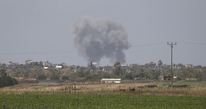
An Israeli drone on Saturday targeted a group of youths east of Gaza City near al-Awda refugee camp. No casualties were initially reported.
Eyewitnesses told Quds Press that an Israeli missile exploded near a group youths who were preparing to launch flaming ballons and kites.
Since March 30, Palestinians in the Gaza Strip have launched dozens of kites and helium balloons bearing flammable materials, and occasionally explosives, sparking near-daily fires that have burned thousands of acres of land in southern Israel.
This came after Israel’s mass killing of more than 130 Palestinians since the start of the Great March of Return.
Eyewitnesses told Quds Press that an Israeli missile exploded near a group youths who were preparing to launch flaming ballons and kites.
Since March 30, Palestinians in the Gaza Strip have launched dozens of kites and helium balloons bearing flammable materials, and occasionally explosives, sparking near-daily fires that have burned thousands of acres of land in southern Israel.
This came after Israel’s mass killing of more than 130 Palestinians since the start of the Great March of Return.
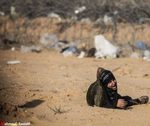
The Palestinian Health Ministry in Gaza has reported that Israeli soldiers injured, Friday, 206 Palestinians, including 44 with live fire, and added that seven of the Palestinians suffered life-threatening wounds.
Dr. Ashraf al-Qedra, the spokesperson of the Health Ministry in Gaza, said 120 of the 206 wounded Palestinians received treatment in filed clinics, and 86 others, including 44 who were shot with live fire, were rushed to several hospitals in the Gaza Strip; seven of them are in very serious conditions. video
He also stated that at least thirty Palestinians suffered the effects of teargas inhalation.
In his statement Dr. al-Qedra denounced the ongoing Israeli military targeting of medics in the Gaza Strip, and said the soldiers shot two medics, including one woman, and added that at least eight of the wounded Palestinians are children.
Media sources in Gaza said the soldiers shot four Palestinians, including two with live fire, in Abu Safiyya area, east of Jabalia, in northern Gaza, before they were rushed to the Indonesian Hospital in nearby Beit Lahia, suffering moderate wounds.
The army also injured several Palestinians with live fire, and gas bombs, east of Khuza’a town, east of Khan Younis, in southern Gaza Strip. One of them was shot with a bullet in his leg and was rushed to the European Hospital.
On June 20th 2018, a young man, identified as Mohammad Ghassan Abu Doqqa, 22, died of wounds sustained when he was shot and seriously injured by Israeli army fire on May 14th, 2018 during the Great Return March protest.
On June 18, 2018, a child identified as Zakariya Hussein Bashbash, 13, died of serious wounds sustained several days earlier when he was shot by Israeli soldiers at a protest in Gaza.
On the same day that Zakariya died from his wounds, Israeli soldiers killed Sabri Ahmad Abu Khader, 24, after shooting him with live fire near the Great Return Camp, east of Gaza city.
Their deaths bring the number of Palestinians who were killed by Israeli army fire since March 30th, 2018 to 129, including thirteen children.
The army also injured 13878 others, including hundreds of suffered serious wounds, mainly after being shot with expanding bullets.
Among the slain Palestinians are two medics, identified as Razan Najjar, 22, and Mousa Jaber Abu Hassanein, 36, while 223 others were injured, and the army caused damage to 37 ambulances.
The army also killed two journalists, identified as Yasser Mortaja, 31, and Ahmad Abu Hussein, 25, and wounded 144 others.
Updated From:
Israeli Soldiers Injure Five Palestinians In Gaza
Jun 22, 2018 @ 16:26
Israeli soldier shot, on Friday evening, at least five Palestinians, including two who were shot with live fire, after the army attacked the “Great Return March” protests along border areas, in the eastern part of the besieged Gaza Strip.
Medical sources at the Indonesian Hospital in Beit Lahia, in northern Gaza, said the soldiers shot two Palestinians with live fire, and two others with gas bombs, near the border fence in Abu Safiya area, east of nearby Jabalia, causing moderate wounds.
The soldiers also fired live rounds at protesters, east of Khuza’a town, east of Khan Younis in southern Gaza, wounding one Palestinian in his leg, before he was rushed to the European Hospital, while several others suffered the effects of teargas inhalation.
Furthermore, dozens of Palestinians suffered the effects of teargas inhalation, after the soldiers fired a barrage of gas bombs at protesters, east of Gaza.
Several Palestinians also burnt tires, and flew burning kites, in addition to flying balloons carrying Palestinian flags.
Dr. Ashraf al-Qedra, the spokesperson of the Health Ministry in Gaza, said 120 of the 206 wounded Palestinians received treatment in filed clinics, and 86 others, including 44 who were shot with live fire, were rushed to several hospitals in the Gaza Strip; seven of them are in very serious conditions. video
He also stated that at least thirty Palestinians suffered the effects of teargas inhalation.
In his statement Dr. al-Qedra denounced the ongoing Israeli military targeting of medics in the Gaza Strip, and said the soldiers shot two medics, including one woman, and added that at least eight of the wounded Palestinians are children.
Media sources in Gaza said the soldiers shot four Palestinians, including two with live fire, in Abu Safiyya area, east of Jabalia, in northern Gaza, before they were rushed to the Indonesian Hospital in nearby Beit Lahia, suffering moderate wounds.
The army also injured several Palestinians with live fire, and gas bombs, east of Khuza’a town, east of Khan Younis, in southern Gaza Strip. One of them was shot with a bullet in his leg and was rushed to the European Hospital.
On June 20th 2018, a young man, identified as Mohammad Ghassan Abu Doqqa, 22, died of wounds sustained when he was shot and seriously injured by Israeli army fire on May 14th, 2018 during the Great Return March protest.
On June 18, 2018, a child identified as Zakariya Hussein Bashbash, 13, died of serious wounds sustained several days earlier when he was shot by Israeli soldiers at a protest in Gaza.
On the same day that Zakariya died from his wounds, Israeli soldiers killed Sabri Ahmad Abu Khader, 24, after shooting him with live fire near the Great Return Camp, east of Gaza city.
Their deaths bring the number of Palestinians who were killed by Israeli army fire since March 30th, 2018 to 129, including thirteen children.
The army also injured 13878 others, including hundreds of suffered serious wounds, mainly after being shot with expanding bullets.
Among the slain Palestinians are two medics, identified as Razan Najjar, 22, and Mousa Jaber Abu Hassanein, 36, while 223 others were injured, and the army caused damage to 37 ambulances.
The army also killed two journalists, identified as Yasser Mortaja, 31, and Ahmad Abu Hussein, 25, and wounded 144 others.
Updated From:
Israeli Soldiers Injure Five Palestinians In Gaza
Jun 22, 2018 @ 16:26
Israeli soldier shot, on Friday evening, at least five Palestinians, including two who were shot with live fire, after the army attacked the “Great Return March” protests along border areas, in the eastern part of the besieged Gaza Strip.
Medical sources at the Indonesian Hospital in Beit Lahia, in northern Gaza, said the soldiers shot two Palestinians with live fire, and two others with gas bombs, near the border fence in Abu Safiya area, east of nearby Jabalia, causing moderate wounds.
The soldiers also fired live rounds at protesters, east of Khuza’a town, east of Khan Younis in southern Gaza, wounding one Palestinian in his leg, before he was rushed to the European Hospital, while several others suffered the effects of teargas inhalation.
Furthermore, dozens of Palestinians suffered the effects of teargas inhalation, after the soldiers fired a barrage of gas bombs at protesters, east of Gaza.
Several Palestinians also burnt tires, and flew burning kites, in addition to flying balloons carrying Palestinian flags.
Page: 33 - 32 - 31 - 30 - 29 - 28 - 27 - 26 - 25 - 24 - 23 - 22 - 21 - 20 - 19 - 18 - 17 - 16 - 15 - 14 - 13 - 12 - 11 - 10

